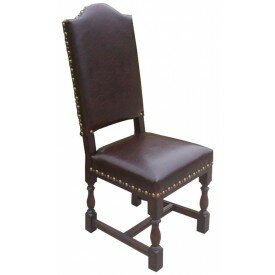The Jacobean period began in 1603 and continued until 1688 or 1689. While most may think that all Jacobean designs are very similar, it is worth mentioning that there were three distinct furniture styles that fall under the umbrella of the Jacobean period, occasionally referred to as the Stuart Period.
1603-1649, King James I and King Charles I

Example of an upholstered Jacobean Chair
During the first part of the Jacobean period under the rule of James I and Charles I. For those who are well versed in furniture period and design, the first part of period, from 1603 through 1649 is often referred to the a Jacobean Period, while the two following eras although still under the Jacobean umbrella are often referred to as the Cromwellian period and the Carolean period.
The basic design and style of furniture during the first part of the Jacobean Period were almost non-existent. The furniture was rather plain and somewhat ordinary for the time, as well as slightly uncomfortable.
1649-1660, The Period of the Commonwealth or the Cromwellian Period

Cromwellian Chair
During the second part of the Jacobean Period, the style of furniture is often referred to as the Cromwellian Period as the Commonwealth was under the reign of Cromwell. The Cromwellian Period was very similar in styling to that of the first part of the Jacobean period, coming under heavy influence of the Puritans.
Both the Jacobean Period (specifically the years from 1603-1649) and the Cromwellian Period were distinguished by plainness and a lack of fine points of design. Self-abasement was taught through the religious creeds. The strict religious disciplines of the time required personal discomfort. All these practices were essential to saving the soul. The furniture of the second part of the period reflected the even more plainness and the necessity for uncomfortable furniture seemed to reach its peak.
During both the early Jacobean and Cromwellian periods the Jacobean furniture was well built but often bulky with little refinement. There was little if any comfort to be found in the furniture of the two periods. The lines of the furniture were uncompromisingly straight. Some have said that anything "beautiful" about the furniture of these two periods was by accident rather than intelligent design.
There was little detail or ornamental design to the furnishings of the times. The Puritanical attitude of the era would have considered anything ornate to be frivolous, something that was frowned upon, and as such it would have been considered a sin.
At the beginning of the period the furniture was heavy and cumbersome. Oak was the wood of choice because of its availability. The average family had furniture made from cheaper wood such as elm, chestnut or beech.
1660-1689, The Carolean Period

Carolean Table Set
During the third part of the Jacobean Period the style became known as Carolean and lasted through the reigns of both James II and Charles II.
The Jacobean style furniture had great influence on the early colonial furniture of America. It was during the Jacobean period that the colonists began leaving England taking with them a few pieces of furniture and holding to the styles to which they had become accustomed.
It bears mentioning that chairs were not all that common during the early part of the 1600's. When chairs were constructed, as with the other pieces of the period the design was based on squares, rectangles and cubes. There was very little curvature to be found.
Until Cromwell chairs were a relative unknown piece of furniture in English homes. Only the upper classes had chairs. The more common folks used stools, although rare, or what is known as long forms. Today we would refer to long forms as low tables or backless benches.
Over time turning of legs and stretchers were incorporated into the furniture removing some of the austerity and rigidity of the pieces. Crude carvings were eventually added near the end of the Carolean period. Broad inlays were added to the designs. Occasionally painted designs were incorporated into the latter pieces.
Few pieces were upholstered. Most of the seats of chairs were wood or rush.
Generally speaking the furniture of the Jacobean period was heavy with little design and less comfort.
There are eight basic characteristics to help recognize the design of the Jacobean Period.
The William and Mary style followed the Jacobean period.


You must log in to post a comment.